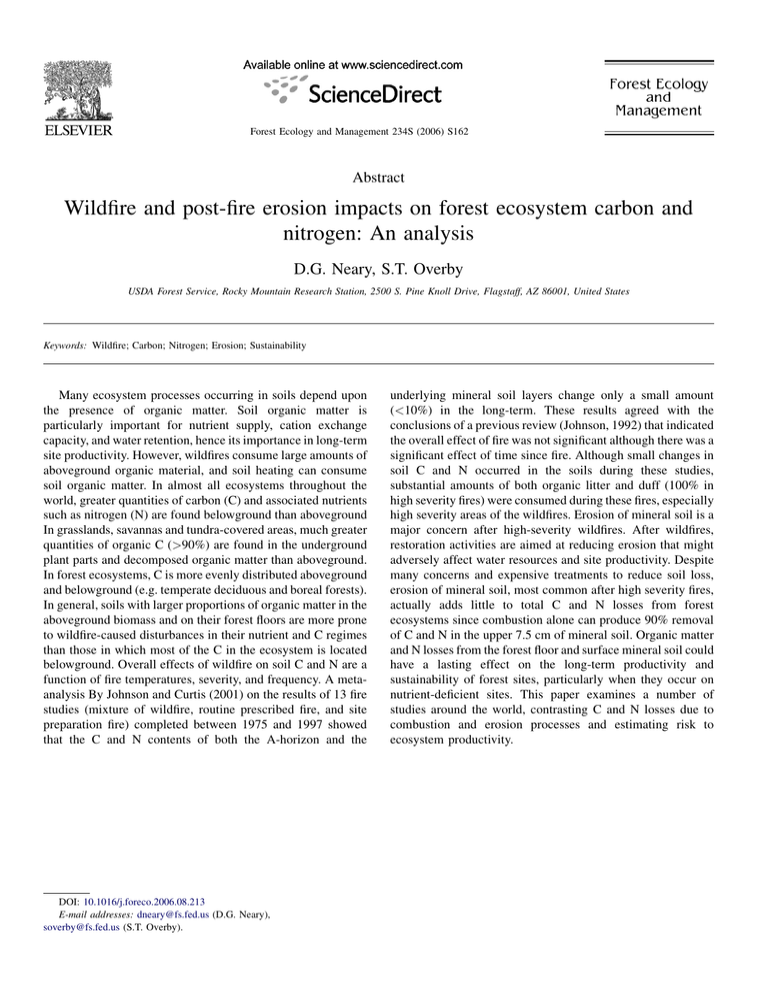Wildfire and post-fire erosion impacts on forest ecosystem carbon and Abstract
advertisement

Forest Ecology and Management 234S (2006) S162 Abstract Wildfire and post-fire erosion impacts on forest ecosystem carbon and nitrogen: An analysis D.G. Neary, S.T. Overby USDA Forest Service, Rocky Mountain Research Station, 2500 S. Pine Knoll Drive, Flagstaff, AZ 86001, United States Keywords: Wildfire; Carbon; Nitrogen; Erosion; Sustainability Many ecosystem processes occurring in soils depend upon the presence of organic matter. Soil organic matter is particularly important for nutrient supply, cation exchange capacity, and water retention, hence its importance in long-term site productivity. However, wildfires consume large amounts of aboveground organic material, and soil heating can consume soil organic matter. In almost all ecosystems throughout the world, greater quantities of carbon (C) and associated nutrients such as nitrogen (N) are found belowground than aboveground In grasslands, savannas and tundra-covered areas, much greater quantities of organic C (>90%) are found in the underground plant parts and decomposed organic matter than aboveground. In forest ecosystems, C is more evenly distributed aboveground and belowground (e.g. temperate deciduous and boreal forests). In general, soils with larger proportions of organic matter in the aboveground biomass and on their forest floors are more prone to wildfire-caused disturbances in their nutrient and C regimes than those in which most of the C in the ecosystem is located belowground. Overall effects of wildfire on soil C and N are a function of fire temperatures, severity, and frequency. A metaanalysis By Johnson and Curtis (2001) on the results of 13 fire studies (mixture of wildfire, routine prescribed fire, and site preparation fire) completed between 1975 and 1997 showed that the C and N contents of both the A-horizon and the DOI: 10.1016/j.foreco.2006.08.213 E-mail addresses: dneary@fs.fed.us (D.G. Neary), soverby@fs.fed.us (S.T. Overby). underlying mineral soil layers change only a small amount (<10%) in the long-term. These results agreed with the conclusions of a previous review (Johnson, 1992) that indicated the overall effect of fire was not significant although there was a significant effect of time since fire. Although small changes in soil C and N occurred in the soils during these studies, substantial amounts of both organic litter and duff (100% in high severity fires) were consumed during these fires, especially high severity areas of the wildfires. Erosion of mineral soil is a major concern after high-severity wildfires. After wildfires, restoration activities are aimed at reducing erosion that might adversely affect water resources and site productivity. Despite many concerns and expensive treatments to reduce soil loss, erosion of mineral soil, most common after high severity fires, actually adds little to total C and N losses from forest ecosystems since combustion alone can produce 90% removal of C and N in the upper 7.5 cm of mineral soil. Organic matter and N losses from the forest floor and surface mineral soil could have a lasting effect on the long-term productivity and sustainability of forest sites, particularly when they occur on nutrient-deficient sites. This paper examines a number of studies around the world, contrasting C and N losses due to combustion and erosion processes and estimating risk to ecosystem productivity.


